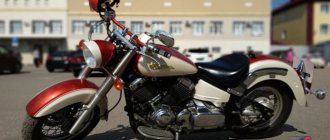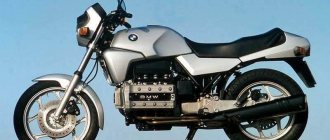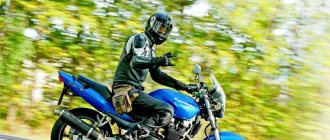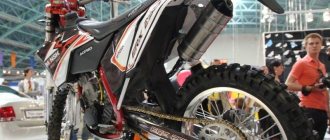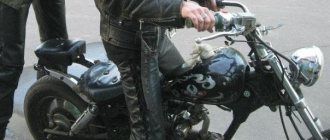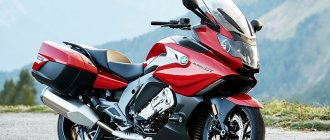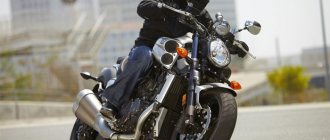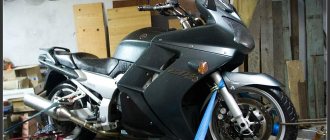- motorcycle model, Yamaha brand,
The Yamaha FJR 1300 sports tourer model was first introduced in 2001 as a successor to the obsolete version of the Yamaha FJ 1200. Despite the stated continuity, the FJR 1300 model has become a completely independent development and has nothing in common with the previous FJ1100/FJ1200 models. From the very beginning, the motorcycle positions itself as the flagship sport-tourer in the Yamaha line of models, intended for sales in foreign markets - in particular, Europe and North America. In addition, the Yamaha FJR 1300 was officially available in a number of other countries - for example, in Oceania and South Africa.
The Yamaha FJR1300 was based on an in-line 4-cylinder liquid-cooled injection engine with a capacity of 1298 cc. see, producing 143 hp. power and 134 Nm of torque. In 2013, the catalysts were optimized and maximum power increased to 146 hp and torque to 138 Nm. Maximum engine performance is achieved at 7000-8000 rpm. Despite the outstanding technical characteristics, the official fuel consumption is stated at 6.2 l / 100 km.
Other features of the Yamaha FJR1300 include an aluminum frame, the ability to electronically adjust the suspension (AE version since 2013), cruise control, an electrically adjustable windshield, seat height adjustment, a combined braking system with ABS, and the availability of versions with a semi-automatic transmission (electronic clutch on AS/AE versions), traction control system, 6-speed gearbox (from 2021), 25 liter fuel tank, cardan drive and 275 kg curb weight.
Bike features
Here are the main features of this model, bright in every sense:
- massive dimensions even for a sports touring motorcycle;
- good brakes, which, however, will not save a beginner from a sudden start;
- Possibility of both sports and classic landings.
The motorcycle can be hung with panniers, which are made at a high level. However, not every person, even if he is a three-time traveler, will be satisfied with the width of the bike along with such a body kit of 1250 mm. If the need arises to take a bunch of things with them, many will prefer the usual tourist classics.
Engine
Torque of 136 Nm and power of 140 hp. – very decent maximum characteristics for such a machine. In-line, the engine is a liquid-cooled four. The top speed here is 260 km/h, which is very good for a motorcycle that began its journey back in the early 2000s. The bike won't even need 3 seconds to reach a speed of 100 km/h.
Yamaha FJR1300A. The Motherland is calling
From its very appearance, the motorcycle aroused in people the desire to go on a long journey. Among the variety of modern bikes, there are also touring models specially designed for travel. The sports touring Yamaha FJR1300A is a prominent representative of this type
Natalia Umnova
Yamaha FJR1300A. Price: from 812,000 rub. On sale: since 2013. From its very appearance, the motorcycle aroused in a person the desire to go on a long journey. Among the variety of modern bikes, there are also touring models specially designed for travel. The sports touring Yamaha FJR1300A is a prominent representative of this type.
Yamaha FJR1300A. Photo: Alexey Voznyuk
The Yamaha FJR1300A is a sport-touring motorcycle designed to cover long distances quickly (this is the key!). This device loves endless smooth straight lines, on which it can accelerate to 250 km/h, or no less smooth curves - European coasts and serpentines, where it takes turns with pleasure... That is why I decided to test the FJR1300A in “non-target” conditions - on the roads of central Russia and the Volga region, although quite straight, but clogged with trucks and not always smooth.
Heated grips are standard, and saddlebags are an option. It’s strange, but perhaps the package will be changed. Photo: Alexey Voznyuk
One of the sections of the route made FJR and I nervous: the seemingly smooth surface actually had ripples, on which the motorcycle jumped and twitched slightly. Here the telescopic fork and the driver had a hard time: a simple “telescope” handles bumps worse than an inverted one, all the cracks and bumps fall into the hands, which bear the entire weight of the driver during a sports-tourist landing. But despite this, we overcame the unpleasant section without losses, only reducing the speed to 80 km/h.
Yamaha FJR1300A. Photo: Alexey Voznyuk
The rest of the route, when there was no heavy traffic, went faster, although there were no empty straight lines to accelerate much - you just unscrew the handle and a truck loomed ahead or the smooth road ended. And the motorcycle clearly wanted to be annealed! In-line “four” with a volume of 1298 cm3 and a power of 146 hp. With. with a torque of 138 Nm in “touring” mode, it operates smoothly at 3–4 thousand rpm, powerfully and smoothly accelerating the motorcycle from any speed. But as soon as you pick up speed or switch to “sport” mode, the device transforms (it’s not for nothing that it’s a sports tourer, that is, 2 in 1), a trembling runs through the body, and it leaps forward - just hold on!
The only drawback of the motorcycle is the rear view mirrors attached to the fairing: they get in the way in traffic jams. Photo: Alexey Voznyuk
The reserve of dynamics in any mode of engine operation is enough for quick, safe overtaking at any speed, however, excellent aerodynamics and a button-adjustable windshield do not allow you to fully experience this speed - you cannot catch the wind in your face and chest. But you don’t have to strain yourself, clinging to the motorcycle so as not to blow away. Plus, on the FJR you can easily raise the saddle a couple of centimeters and adjust the position of the handlebars.
Comfort is also added by the air flow distribution system, which directs heat from the engine to the driver’s feet - a great thing in cool and wet weather. But in the heat and in a traffic jam, when additional air cooling does not work, it greatly interferes: you don’t know where to put your feet from the blazing engine.
Yamaha FJR1300A. Photo: Alexey Voznyuk
Like a self-respecting modern motorcycle, the Yamaha FJR1300A is equipped with ABS, while the brakes themselves work perfectly, adequately and predictably slowing down the device from any speed. In addition, there is a switchable traction control system (TCS), which prevents stalling and slipping of the rear wheel, which is valuable when driving in the rain and when cornering, which the FJR handles perfectly - it’s not for nothing that it has a sports aluminum frame. But even though there are seven bends per mile on Russian roads, sharp turns where you can go all the way to the running boards are rare.
Cruise control works at 50–180 km/h, giving rest to the right hand. Photo: Alexey Voznyuk
The motorcycle provided a pleasant feeling even in not the most pleasant conditions. With the Yamaha FJR1300A you can be sure: when you are fed up with smooth Europe, and the Motherland calls you to taste its immense distances, it will not shy away from this challenge.
Yamaha FJR1300A. Photo: Alexey Voznyuk
Yamaha FJR1300A
| Dimensions (length x width x height x seat height) | 2230x750x1325x805 (825) |
| Base | 1545 mm |
| Ground clearance, mm | 130 |
| Fuel tank capacity l | 25 |
| Engine | 1298 cm3, 4-cylinder, in-line, 4-stroke, liquid-cooled, injector, 146/8000 l. s./min-1, 138/7000 Nm/min-1 |
| Transmission | 5-speed manual gearbox, multi-plate clutch, oil bath, drive - cardan shaft |
| Frame | aluminum, diagonal |
| Front suspension | telescopic fork, ∅ 48 mm, stroke 135 mm |
| Rear suspension | adjustable monoshock, 125 mm travel |
| Front brakes | 2 discs ∅ 320 mm |
| Rear brakes | hydraulic 1 disc ∅ 282 mm |
| Dry weight | 259 kg |
| Technologies | ABS, traction control, cruise control |
The editors recommend:
How to reduce washer fluid consumption?
Russians will be able to catch traffic violators on their phones
Where is it better to store a car - in a garage or outside? Opinions for and against
Advanced truck driver and savings on service: what do cargo carriers rely on?
New law: fine drivers for speeding 5 km/h
Discussion Cancel
I want to receive the most interesting articles
Dimensions and weight
The dry weight here is 250 kg, but taking into account the 25 liter tank it increases to approximately 290 kg. No, the bike feels light on country roads and handles great. However, riding the FJR 1300 in the city is a completely different story. The saddle height of 850 mm makes the model clearly unsuitable for people of short and even average height.
Review of the Yamaha FJR 1300 motorcycle
The first flight on a motorplane after the purchase began in city traffic jams, in comparison with other motorcycles that I used before the purchase, nothing unusual, the motorcycle brakes and accelerates like all powerful motorcycles, nothing special, of course there is a privilege - electric glass, the wind picked up somewhere nearby, you can walk 200 km/h without a helmet, even your eyes don’t water, and the passenger is comfortable - you can fall asleep on a good road, and in cold weather this electric glass and heated handles that come in the base save your health. I heard different opinions about the handling of this motorcycle in traffic jams; sport bikers complained about its heavy weight - 300 kg. with a full tank. The FJR does not feel heavy, it allows you to easily clear traffic jams, easily maneuver between cars, and at minimum speed it is not prone to stalling even with a passenger. The speed can reach 5 km/h, the engine speed is slightly more than 1100 rpm and it pulls like a steam locomotive. Dimensions without panniers allow you to pass through narrow places without stress. If the handlebar goes through, the whole motorcycle goes through! I use a motorcycle with panniers in traffic jams and keep up with sports. True, you go up to 200 with them, and then they pass you like a man (145 hp at 8500 rpm is not enough to pull over 200). Handling on a straight line is such that you sit in the passenger seat and write text messages at a speed of more than a hundred, but for this trick you need cruise control, at least mechanical.
The first few kilometers in traffic jams were not easy, the high center of gravity and almost 300 kg of weight made themselves felt... at low speed the bike fell over, and two more side (standard) cases did not allow me to relax... but I was very, incredibly happy with our acquaintance with him, the understanding grew and I became more and more involved... having arrived at the MREO and finding a day off there, I decided to go to the dacha, show my wife, children and family... 100 km, the flight was normal, the trip along the highway tripled the euphoria and I was already at in seventh heaven...my wife was delighted with its appearance, sound and comfortable seating)...showed it to my wife, went to my mother’s dacha...200 km, the flight was normal, it was as if we had always been together)...mother was happy with her son’s choice, parting speech and I’m already rushing towards the city... 300 km, the flight is normal, the bike is in the stall, I’m in euphoria, there’s no hint of fatigue... it exceeded all my expectations!!!! then there were trips to festivals, to dachas, just rides, the biggest distance was to Svirstroy 250 km one way, here he showed his best side, the trip back took 2.5 hours, the wife was also in euphoria and then upon arrival home a long time she couldn’t calm down, she was bursting with pleasure... in almost three months of riding, 3,500 thousand km had accumulated.... the last ride was on November 11, in the drizzling rain and at +5 we closed this season, right now it’s standing clean and under a cover, and is waiting for a new season, well, I’m waiting for the same thing…………peace be with us)
The tank holds 20 something, enough for about 400 km. along the highway. It's difficult around the city. 1300 at maximum speeds swallow the “salyar” very quickly, so it’s hard to say.
And the mot is super. Reliable, comfortable, wind protection 5+. When I took it, I was afraid that it wouldn’t be convenient in the city: It’s more comfortable on a maxi scooter, it’s more comfortable on a 400 scooter, and it’s less convenient on a 600 GSX600-F KATANA. Acceleration is a plague. The brakes are decent, but it’s a bit difficult to slow down such a carcass. In 2 years, not a single breakdown, ugh ugh ugh. Consumables are no more expensive than others. Highly recommend
I have a 2006 Fyzher in the 3rd generation. I wouldn't say that I have problems with a high center of gravity when driving. on the contrary, you can push through traffic jams at a snail's pace and never touch the ground with your foot. before that I owned a Susa “Hooligan-750”, it seems that the bike is almost 70 kg lighter, and the seat position is lower, and at low speeds you keep pressing your feet into the ground. in September last year it decomposed a little. I started looking for plastic. On the 1st and 2nd generation fizhs, the spare parts are just a lot and for practically pennies, which cannot be said about the wasts starting from 2006. spare parts are much more expensive. As for long-range shooting, of course, the device is simply brilliant! But for Moscow traffic jams, IMHO, you need a nimble and narrower motor. Overall, I am very pleased and have no plans to change yet.
Excruciating choice of model, reviews and reviews from owners - and now I have decided on the Yamaha FJR 1300 model! All that remains is to find this model live and look at it and try it on. I made a special trip to the Yamaha showroom in Moscow - it was out of stock at the end of the season. And then I walk into our Yamaha showroom and see him! It was like an electric shock! I sat down, tried the weight and rolled with my hands, started the engine! Exactly what I was looking for! One thing confused me - the price tag! In short, I bought it a little older from the States but the condition is excellent.
And now the beginning of this season has arrived. I did some maintenance on the engines - changing the engine oil and rear gearbox. And go ahead - the feeling is amazing! The seating position is comfortable, the windshield is adjustable in height and allows you to almost completely cut off the air flow from the helmet - one caveat - my bike came with spacers on the handlebars, which raised it up a little and further strengthened the vertical fit, which is undoubtedly comfortable, but the standard glass is no longer enough and the flow the wind hits the forehead. If you install a higher tuning glass, it will be absolutely comfortable. After a sports bike, when at speeds over 100 you have to bend down, but at 200 you just lie on your heap on the tank and ride like that. Here I calmly move 250 with a straight back and no discomfort.
Further on the engine - on a Honda it was necessary to constantly turn the engine so that the torque did not disappear - Let's say you are walking along the 150 highway in 6th gear and you need to speed up to overtake - but the engine doesn’t really move, you have to drop a couple of gears down and spin the engine. In principle, it’s not like that and it’s difficult, but when you do it all the time, it gets boring. Everything is simple here - an engine with a capacity of 1300 and amazing traction from the very bottom allows you to drive in 5th, the last gear, absolutely along the entire highway. You accelerate and 80 km, turn on 5 and you're in drive mode. The engine allows you to do absolutely everything - you can reduce the engine speed to idle - that's 800 rpm and drive at a speed of 30 km. But you just have to turn the knob in an instant without switching, like in sports , you’re already flying 250! In short, it’s just a long-range driver’s dream.
By the way, the motorcycle is heavy and during sharp acceleration there is no lift of the front wheel, which also affects the safety and comfort of control. The frame of the motorcycle is cast from aluminum and there is a feeling that the motorcycle is like a string - the control is excellent and no worse than the Honda, which is an excellent machine in this matter. In any case, you enter all turns confidently and predictably. Even towards the end of the season, he began to put the bike into turns until sparks came from under the pegs. This year the track for the Game was repaired well and after Bodya the bundle is so tasty there all the time until the cut-off on the footrests. It is very convenient that there are side cases that allow you to store every little thing and the helmet fits perfectly - you don’t need to carry it with you. By the way there are three cases but If you put the central one, then at a speed of over 200 it starts to sail a lot and a sausage appears - quite dangerous.
The presence of a cardan means no problems with lubrication and the wheel is always clean. The brakes, like all motorcycles, brake perfectly and confidently and I don’t feel any failures or overheating, no worse than on a Honda. In general, according to my feelings, this is a sports bike with a comfortable fit - exactly what you need when you can grab it with the breeze and go on a comfortable long-distance trip. This summer I drove through Igra to Ocher and returned through Votkinsk - the flight was 3.5 hours, the ride was very comfortable, about 200 on average - where is faster where is quieter. By the way, he has and the downside is that the heat from the engine is very strong through the lower air vent directly onto your feet. In the summer heat, I once didn’t wear motorcycle boots but just sneakers - my feet almost got fried, it was just really hot in a frying pan. I had to end the trip ahead of time. I’m always in ammunition and, in principle, you can come to terms with this - you don’t feel the heat in motorcycle boots. By the way, the fuel consumption surprised me - about 200 speed, the consumption of 7 liters for a Honda did not fit into the top ten. If you go about 120, then you’ll fit into 5. On the highway, the Yamaha FJR 1300 is very stable due to the large mass and long wheelbase, you can drive through potholes without fear, you won’t fall, which is important on our roads. I described everything in general terms about my impressions of this device. I’m waiting for spring and planning long-distance trips to Perm, Ufa, Kazan. This is exactly its element I hope you will find some interesting information to think about.
Chassis and brakes
The model's suspension is well made. If at the rear there is a typical reliable solution in the form of a pendulum version with a shock absorber, then at the front there is a large telescopic fork, the travel of which is quite free and amounts to 135 mm.
The rear brake is a disc with a two-piston caliper, while the front is a pair of discs with four-piston calipers. The diamond-shaped frame is made of aluminum; apparently, the designers were well aware that the FJR 1300 was already very heavy for its class.
History of changes
During its career, the FJR 1300 has already come a long way:
- 2001 – start of production;
- 2003 – ABS appears;
- 2006 – significant restyling;
- 2008 – improvement of ABS;
- 2013 – large-scale technical changes;
- 2016 – slipper clutch appears.
It’s difficult to say how big the future is for this motorcycle, but even if it suddenly stops being produced, it will not lose its popularity for a long time.
Yamaha FJR1300: electronic options
ABS
YCC-T - Yamaha Chip Control Throttle (electronic throttle) - since 2013
YCC-S - Clutchless Shift System - FJR1300AE/AS/ES
TCS (Traction Control System) (traction control system) - since 2013
Cruise control (electronic cruise control system) - since 2013
Yamaha D-Mode-System - since 2013
Electronic adjustment suspension (electronic suspension) - AS/AE/ES from 2013
